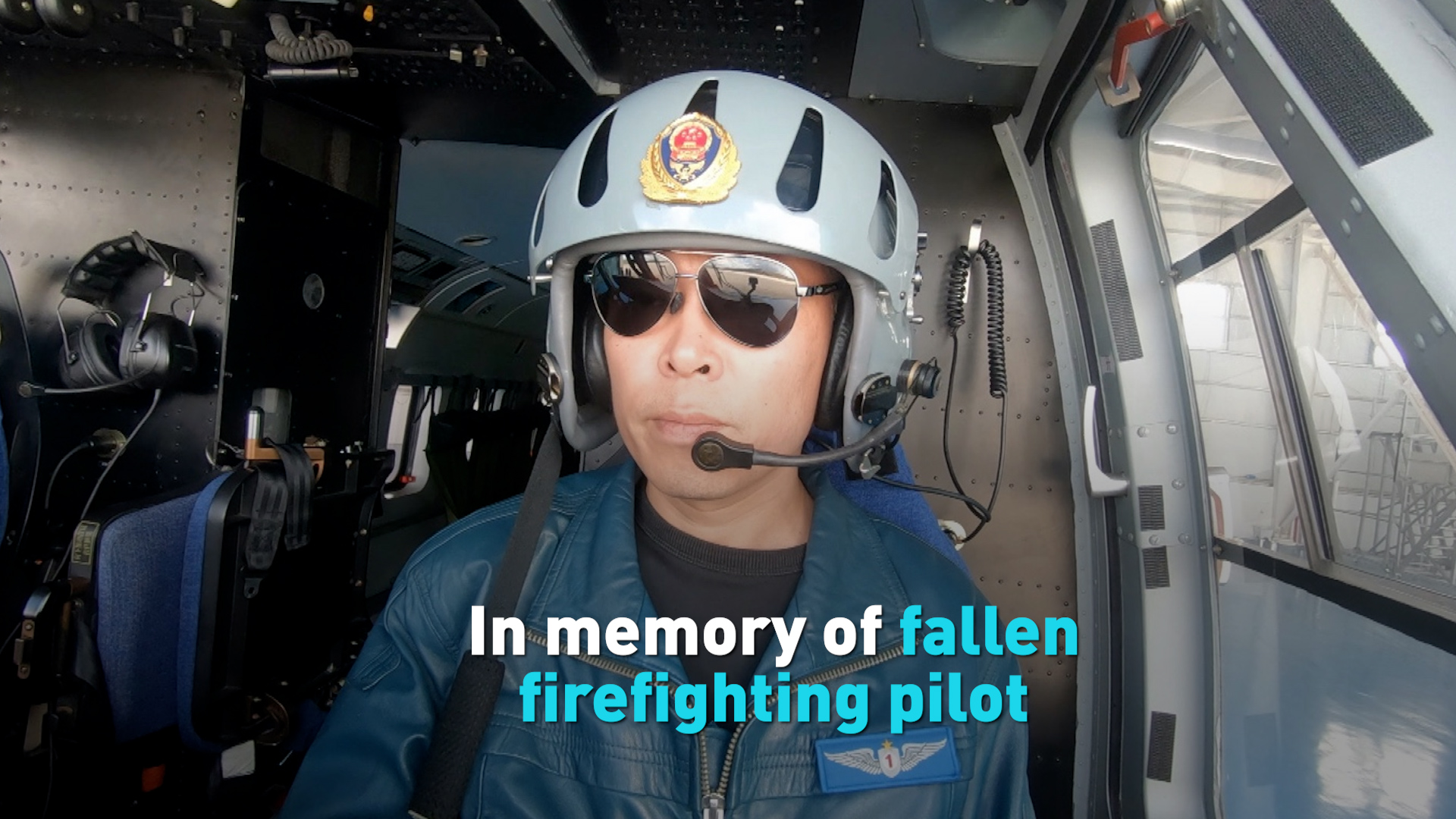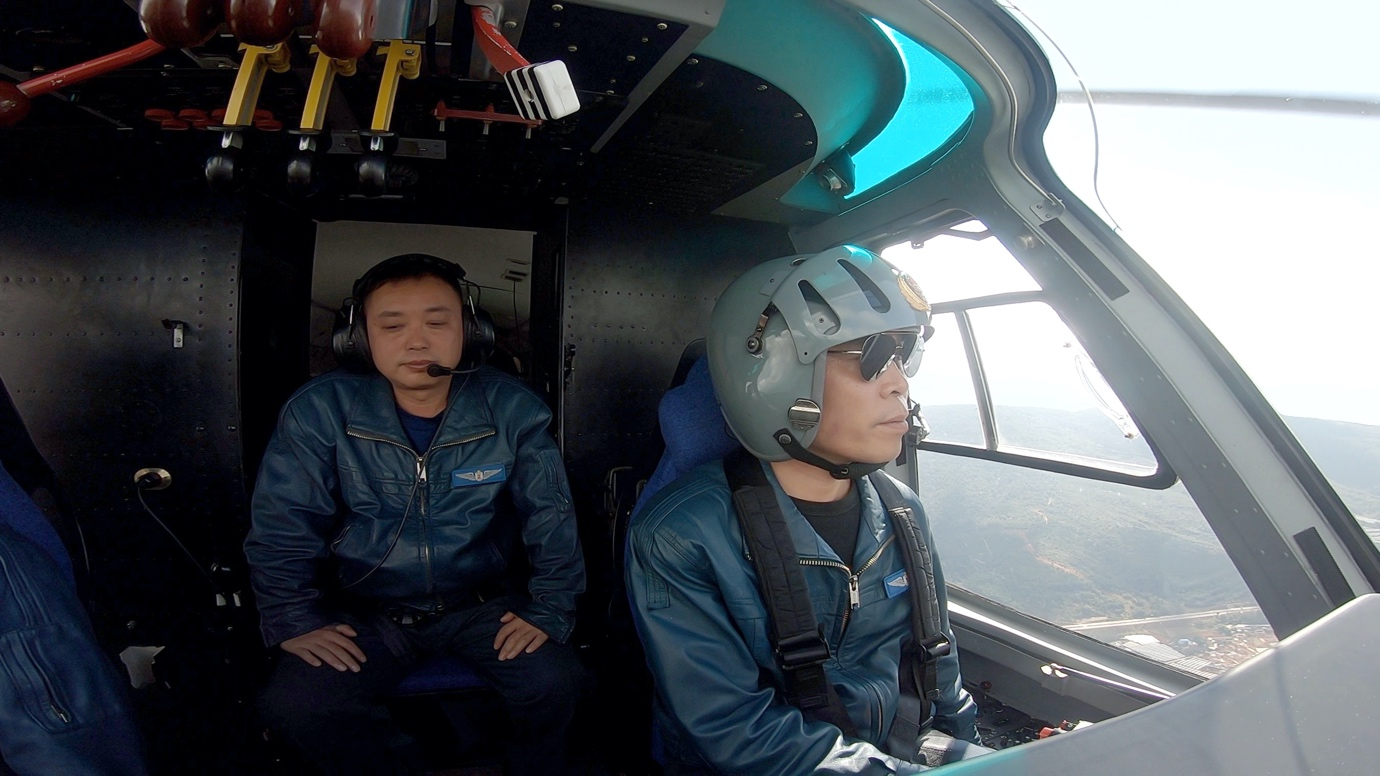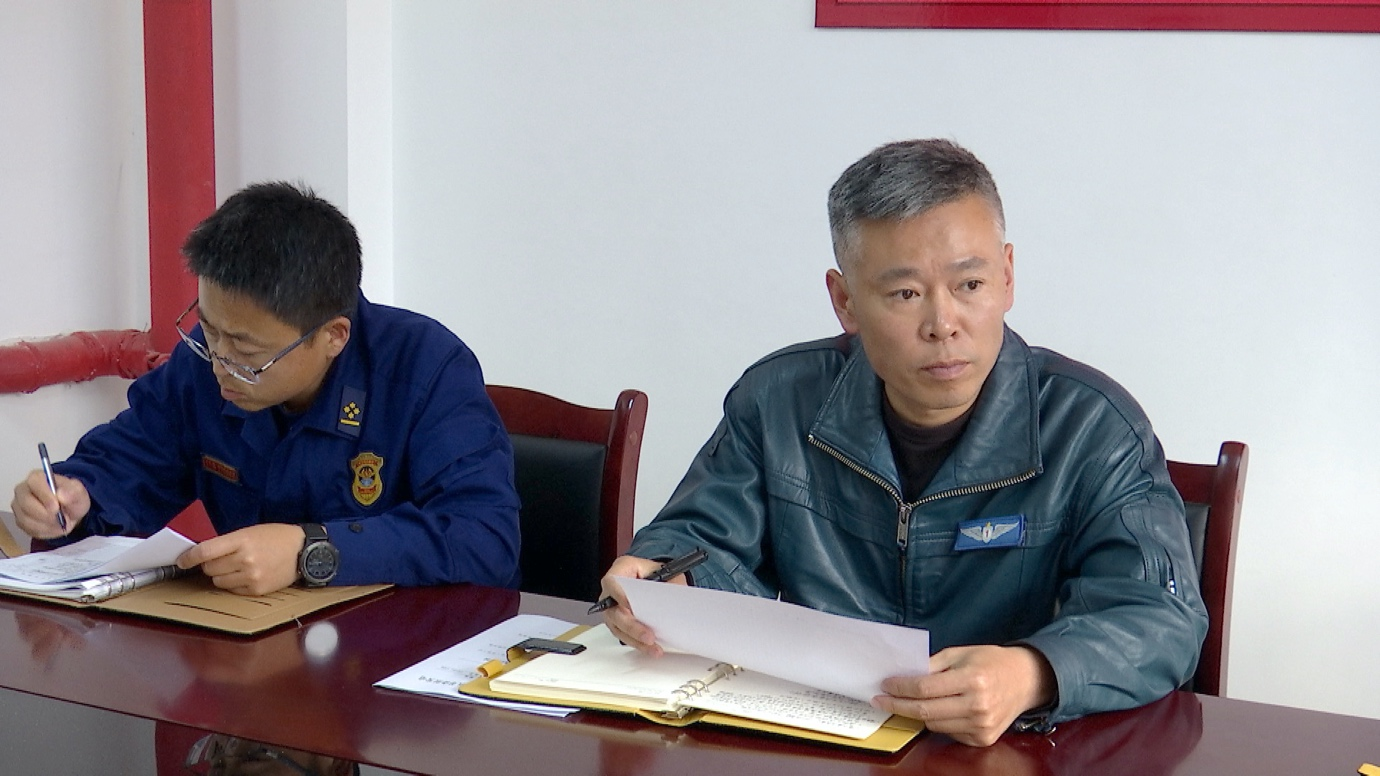04:16

Editor's note: Pilot Liu Hong was among the four crew members who were killed after a firefighting helicopter crashed into Erhai lake on May 10th, 2021 in Dali City, southwest China's Yunnan Province. Back in November, 2019, ahead of China's 28th National Firefighting Day, Liu had an exclusive interview with CGTN, in which he shared his life story and experience in helping contain forest fires. This article is intended to pay tribute to Liu and the three other fallen heroes.
Around 11 a.m. on May, 9th, 2021, a forest fire broke out in Dali city of southwest China's Yunnan Province. The blaze scorched around 48 hectares of land. Over 2,500 people, 21 fire trucks and three helicopters were mobilized to put out the flames.
Liu Hong, a pilot of Kunming Aviation Rescue Detachment under China's Ministry of Emergency Management, was among the firefighting task-force.
Just five days ago, he was combating a separate forest blaze at a different location in the same city. Liu completed his mission on May 4th, and on his WeChat moments, he posted two aerial pictures of the city and bid farewell.
The latest forest fire was fully extinguished by 6:40 a.m. on May 10th, after a day-and-night effort. However, on a mission to fetch water from the nearby Erhai Lake to clear a burnt area caused by the fire, his helicopter began to spin violently over the water and crashed into it at 10:20 a.m.

(Liu Hong posted his last photo on his WeChat moments at 5:27 a.m. on May 10th, 2021, about five hours before his helicopter crashed into the Erhai Lake in Dali City. He used words “Early bird!” to describe it. Photo by Liu Hong.)
(Liu Hong posted his last photo on his WeChat moments at 5:27 a.m. on May 10th, 2021, about five hours before his helicopter crashed into the Erhai Lake in Dali City. He used words “Early bird!” to describe it. Photo by Liu Hong.)
Two crew members were rescued at around 11:40 a.m. and 3:15 p.m. on the same day, respectively, but died despite emergency medical treatment. The other two crew members were found without signs of life at about 2:55 a.m. on the next day.
Liu Hong, after spending over two decades flying, died at the age of 40.
Army Aviation turned Firefighter
Liu Hong was born in 1981 to a humble family in Weiyuan County of Sichuan Province. He was the family's only child. His father, Liu Zhongcai, told local media that as a teenager, Liu Hong was well-behaved and intelligent, and was famously good at drawing cartoon pictures.
In 2000, he enrolled at Chinese People's Liberation Army Aviation School, and four years later, Liu was assigned to serve as a pilot in the PLA Army Aviation, a type of aviation within the Ground Force.
After spending nine years working in the army, in 2013, he transferred to China's Aviation Rescue Detachment in Daqing City in northeast China's Heilongjiang Province, he was responsible for putting out forest fires and conducting emergency rescues.

Pilot Liu Hong inspected the landscape of Kunming City along with his crew members during a drill on November 5th, 2019. CGTN Photo.
Pilot Liu Hong inspected the landscape of Kunming City along with his crew members during a drill on November 5th, 2019. CGTN Photo.
In August, 2018, Liu Hong was dispatched to Kunming City in Yunnan Province. And since then, he's been working on the team fighting forest fires in the southwest part of the country. He tried hard to adapt to the new conditions, as it requires more expertise and stamina to fly on a high-altitude topography – the altitude in Daqing is around 150 meters above the sea level, in Kunming, it's around 2,000 meters.
In early November, 2019, just days ahead of China's 28th National Firefighting Day - which falls on the ninth day of the month every year - our film team visited Kunming Aviation Rescue Detachment located on the top of a mountain range.

Liu Hong showed the helicopter he flies to CGTN reporter Meng Qingsheng on November 5th, 2019. It’s the largest transport helicopter ever made in China. CGTN Photo.
Liu Hong showed the helicopter he flies to CGTN reporter Meng Qingsheng on November 5th, 2019. It’s the largest transport helicopter ever made in China. CGTN Photo.
It was the winter fire season in the province.
When we stepped into the compound, aerial rescuers and supporting staff were maneuvering a drill to cope with wildfires - a common type of natural disasters in the locality given about 60 percent of the province's territory is covered by forests.
A Noble and Glorious Undertaking
We followed Liu Hong all the way from attending sessions to conducting drills during the two-day film trip. The 38-year old man had rich experience in fighting forest blaze and flying helicopters. He was a passionate and eloquent defender of the job he's been engaged in for seven years.
We jumped into his helicopter - the largest transport helicopter ever made in China. It's specially made for conducting firefighting and rescue missions. The aircraft is able to deliver about 30 firefighters, and over three tons of water in a single trip.
What caught my attention was a water-dropping device which allows the helicopter to dump water on fires. In real situations, the pilot can fill the bucket in a lake, a river, or even a pool.

Liu Hong spoke to his team about the focus of work before they start a drill for fighting forest blaze on November 5th, 2019. CGTN Photo.
Liu Hong spoke to his team about the focus of work before they start a drill for fighting forest blaze on November 5th, 2019. CGTN Photo.
In Liu Hong's opinion, “Helicopters are the wings of emergency rescue forces. We are fast moving, unimpeded by roads and terrain, and have low take-off and landing requirements. We can go places that ground teams cannot reach. In my view, this is a noble and glorious undertaking, and one with great prospects.”
China's Aviation Rescue Detachment, formerly known as Helicopter Detachment, was founded in 2009 in Daqing City. It works as part of the Forest Fire Bureau of the Ministry of Emergency Management. The team was split into two branches in 2018 – with the other one installed in Kunming City - following an institutional reshuffle.

Liu Hong was conducting a routine check over his helicopter on November 5th, 2019. CGTN Photo.
Liu Hong was conducting a routine check over his helicopter on November 5th, 2019. CGTN Photo.
“We have to be well-prepared for each task,” Liu explained to us in great detail about how the firefighting mission was usually conducted, “After we arrive at the scene, we first survey the fire site, and evaluate the direction and speed of the wind, and the terrain. Then we work out how we will coordinate operations with ground rescuers.”Liu added that“We work hard to put out fires as soon as possible, to keep damage of the forest to a minimum.”
In 2019, by the time when our filming started, Liu had completed five major forest fire rescue missions. He recalled to us that during one of the tasks, he and his teammates had to fly for ten hours in a row. It's a challenge not just physically but mentally as well. To maintain their combat capability, the whole team had to go through a 1.5-hour physical training program every day.
I asked him what the hardest part of his job. He paused for a second, and then told me it's the“flashovers”in forest fires - a sudden change in fire behavior in which things burst into flames instantly.
“The aircraft is usually flying at a height about 60 meters over the flames. If a flashover happened, for an instant, it will burn up the oxygen in the air. And the helicopter will quickly be pulled into that vacancy,” he explained to me. Liu Hong said he managed to avoid a dilemma in May, 2019, “We changed the flight route the moment when we detected the problem, and stayed clear of it.”

On November 4th, 2019, Liu Hong attended a meeting hosted by Kunming Aviation Rescue Detachment on scenarios of upcoming drill. CGTN Photo.
On November 4th, 2019, Liu Hong attended a meeting hosted by Kunming Aviation Rescue Detachment on scenarios of upcoming drill. CGTN Photo.
At the end of our interview, I asked him for comments on the upcoming National Firefighting Day. And this is what he shared with us,“The establishment of the Firefighting Day is the recognition of our team by the country and the people. We will work harder to do a good job, do not live up to the expectations of the country and the people of our team.”
He added that“I wish all our emergency responders safe, smooth and successful completion of the tasks entrusted by the country and the people in the process of dealing with disasters and accidents and carrying out rescue missions."
Official figures show, China has nearly 200,000 fire rescue personnel. Among them, about 25,000 are responsible for battling forest fires. And the helicopter detachment where Liu Hong worked has about 500 personnel.
Unfortunately, he did not make it upon the completion of his last rescue mission. And now, his 20 or so years of flying experience came to an end. Along with his death, were his three coworkers – pilot Li Kaitao, born in 1988, and aviation mechanics Liu Chao and Sun Zhongjie, born in 1985 and 1982 respectively.

“I haven't had time to accompany you, but in the blink of an eye you’ve all grown up.’’ This photo was posted by Liu Hong on his WeChat moments on February 27th, 2021. Photo by Liu Hong.
“I haven't had time to accompany you, but in the blink of an eye you’ve all grown up.’’ This photo was posted by Liu Hong on his WeChat moments on February 27th, 2021. Photo by Liu Hong.
Liu Hong told us that one of his regrets was being unable to be around with his family – his wife, two children, and parents, who he said were quite supportive of his job as a firefighting pilot.
On February 27th, this year, Liu Hong posted a photo of his two sons - one is three while the other has just turned one – on his WeChat moments, and commented that“ I haven't had time to accompany you, but in the blink of an eye you've all grown up."
It's a pity that he will never have a chance to accompany his two sons, but as a sort of relief that as a pilot, he had tried his best to live his life to the fullest by bringing safety to those in need.
Check out The China Report, our new weekly newsletter. Subscribe here!

